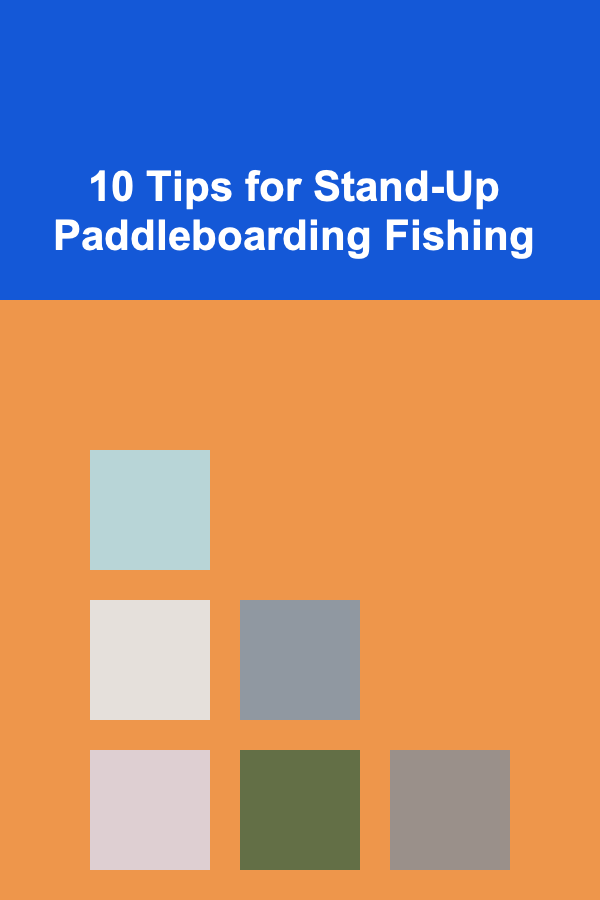
10 Tips for Stand-Up Paddleboarding Fishing
ebook include PDF & Audio bundle (Micro Guide)
$12.99$6.99
Limited Time Offer! Order within the next:

Stand-up paddleboarding (SUP) has gained significant popularity in recent years, and its versatility has opened up new avenues for recreational activities on the water. One such exciting pursuit is stand-up paddleboarding fishing. Combining the peacefulness of paddling with the thrill of fishing, SUP fishing offers a unique and enjoyable way to fish in lakes, rivers, and coastal waters. Whether you're an experienced angler or a newcomer to paddleboarding, there are essential tips and techniques to make the most of your fishing adventures on a stand-up paddleboard.
In this article, we'll cover 10 valuable tips to help you maximize your stand-up paddleboarding fishing experience, from choosing the right equipment to mastering techniques that will increase your chances of success.
Choose the Right Stand-Up Paddleboard
The foundation of any good paddleboarding fishing experience is the board itself. Unlike traditional paddleboards, fishing-specific SUPs are designed to offer greater stability, comfort, and storage space for your gear. When selecting the best paddleboard for fishing, consider the following:
Key Features to Look for in a Fishing SUP:
- Stability: Stability is essential for fishing, especially when casting or reeling in a big catch. Look for a wider board, typically around 32 to 36 inches in width, as it provides more balance.
- Length: Fishing SUPs are often longer than standard paddleboards, ranging between 10 to 14 feet. Longer boards provide greater tracking ability and more space for your gear.
- Weight Capacity: Ensure that the board can support both your weight and the additional fishing gear you plan to bring along.
- Storage: Fishing boards should come with ample storage options, such as bungee cords or cargo areas to stow your tackle box, cooler, and extra gear.
When in doubt, test out different boards to see which one feels most comfortable and stable for your needs.
Select the Right Paddle for Fishing
Your paddle is just as important as your board when it comes to stand-up paddleboarding fishing. The right paddle can make paddling more efficient and help you conserve energy during long sessions on the water. Here's what to look for:
Paddle Characteristics to Consider:
- Material: Paddles made from lightweight materials like carbon fiber or fiberglass will reduce fatigue, allowing for longer and more comfortable paddling. Aluminum paddles are affordable but heavier.
- Length: The general rule of thumb for paddle length is to add 6--8 inches to your height. This provides you with the right length for optimal paddling efficiency and control.
- Blade Shape: A larger blade can provide more power when paddling, but it may create drag. If you're aiming for long distances, consider a narrower blade, while a broader blade is ideal for quick starts and power strokes.
Choosing the right paddle can make your paddleboarding fishing experience smoother and more enjoyable.
Understand Local Regulations and Permits
Before you embark on your fishing adventure, it's important to familiarize yourself with the local fishing regulations and obtain any necessary permits. These regulations can vary widely depending on your location, and failing to comply could result in fines or legal issues.
Steps to Take:
- Research Local Laws: Check out fishing regulations for the area where you plan to fish. Look into permitted species, catch limits, fishing seasons, and any restricted zones (e.g., wildlife reserves or no-fishing areas).
- Permits and Licenses: Some regions require you to have a fishing license, while others may have specific permits for water-based fishing. Ensure that you're legally allowed to fish before heading out.
- Safety Regulations: Make sure to follow local water safety laws, including wearing a life jacket or using other required safety gear.
Being well-informed about regulations and permits ensures that you stay safe and avoid unnecessary complications during your fishing trip.
Master Paddleboarding Techniques for Fishing
Although fishing on a paddleboard can seem easy, there are specific techniques that you'll need to master to ensure that you stay stable, maneuver efficiently, and cast effectively. Here are some key skills to develop:
Key Techniques to Practice:
- Proper Paddling Stance: Keep your feet shoulder-width apart with a slight bend in your knees. This stance helps maintain balance and makes it easier to adjust when casting or fighting fish.
- Stroke Technique: To move forward, use long, smooth strokes that reach the water's surface at a 45-degree angle. Keep your paddle close to the board for maximum efficiency.
- Turning and Pivoting: Learn how to use your paddle to turn smoothly. To make a quick pivot, push on one side of the board with your paddle while simultaneously drawing the other side in.
- Casting from a Paddleboard: Casting can be a bit tricky on a SUP because of the limited space and the risk of tipping over. Practice casting techniques that allow you to maintain your balance while ensuring your line lands in the right spot.
Mastering these basic skills is essential for a safe and successful fishing session.
Bring the Right Gear
When fishing from a stand-up paddleboard, it's crucial to pack the right gear for the job. Your fishing equipment should be compact, easy to manage, and suited to the environment you're fishing in. Here's what to bring:
Essential Fishing Gear:
- Rod and Reel: Choose a compact rod that is easy to store and handle on a SUP. A 6 to 7-foot rod is usually ideal for fishing from a board. A reel with a smooth drag system and an appropriate line is essential.
- Tackle Box: Bring a small, waterproof tackle box that holds a variety of baits, lures, hooks, and other essentials. Make sure it's securely fastened to your board.
- Fishing Net: A compact fishing net is essential for landing your catch without harming it or losing it in the water.
- Cooler/Storage: A cooler with straps or a storage bag is useful for storing fish, beverages, and snacks. Make sure it's secured to prevent it from tipping overboard.
The goal is to have everything you need for a successful fishing trip, without weighing down your paddleboard.
Choose the Right Time and Location
Choosing the right time and location is key to successful stand-up paddleboarding fishing. Different species of fish are active at different times of day, and their behavior can change depending on environmental factors.
Best Time to Fish:
- Early Morning and Late Evening: Fish are most active during the early hours of the morning and later in the evening. These are the best times to catch species such as bass, trout, and pike.
- Weather Conditions: Overcast days can be great for fishing as fish are less wary of predators. Calm, flat water also provides better visibility and a more stable platform for fishing.
- Tides and Moon Phases: In coastal areas, tides and lunar phases play a significant role in fish movement. Plan your fishing trips around favorable tidal times and full moons for the best results.
Research your fishing spots and know the optimal times for different species to ensure you're fishing at the right time.
Maintain Balance While Fishing
Fishing from a stand-up paddleboard requires constant attention to your balance. Unlike fishing from a boat, you have less stability, which means you need to be more mindful of your movements and the conditions around you. Here's how to stay balanced:
Tips for Maintaining Balance:
- Use Your Core: Engage your core muscles to maintain stability. Keep your hips loose and avoid making sudden movements that might cause you to lose your balance.
- Move Slowly and Carefully: Avoid unnecessary movement. If you need to reposition or reach for something, do so slowly and with purpose.
- Stay Low: If you're trying to maintain balance while reeling in a big fish or adjusting your gear, lower your body by slightly bending your knees. This lowers your center of gravity and helps prevent tipping.
Being mindful of your balance will keep you safe and make your fishing experience more enjoyable.
Use a Leash for Safety
One of the most important safety measures when stand-up paddleboarding is to use a leash. A leash ensures that you don't lose your paddleboard if you fall into the water, and it also helps you stay attached to your gear.
Types of Leashes:
- Coiled Leash: This type of leash stretches when needed and remains compact when not in use. It's great for fishing in calm waters.
- Straight Leash: Ideal for choppier waters or open ocean paddleboarding. It keeps you connected to your board, no matter the conditions.
A leash adds an extra layer of security, ensuring that even if you fall off the board, you won't lose it or your fishing gear.
Know How to Fight and Land Fish
Fishing from a stand-up paddleboard means you need to be strategic when battling and landing a fish. It's important to fight fish efficiently without losing your balance or risking damage to your equipment.
Tips for Fighting Fish:
- Keep the Line Tight: Maintain a firm grip on the rod and reel to keep the line tight. This will help you fight the fish more effectively and reduce the chances of losing it.
- Use Your Paddleboard to Your Advantage: Stay centered on the board to maintain balance. Use the paddle to maneuver the board toward the fish, allowing you to keep a steady line tension.
- Land the Fish Carefully: Once the fish is close, use a net to gently scoop it out of the water. Be careful not to overexert yourself or the fish during the landing process.
Mastering the techniques of fighting and landing fish on a SUP is a skill that improves with practice.
Reading More From Our Other Websites
- [Personal Investment 101] How to Understand Real Estate Market Trends
- [Survival Kit 101] Best Disaster‑Ready Survival Kit for RV Living: On‑the‑Road Self‑Sufficiency
- [Home Staging 101] How to Stage a Small Home for First-Time Homebuyers on a Budget
- [Home Lighting 101] How to Use Natural Light to Brighten Up Your Home
- [Home Storage Solution 101] How to Maximize Your Bathroom Cabinet Storage Space
- [Hiking with Kids Tip 101] Gear Up and Go: Essential Checklist for Kids' First Hiking Adventure
- [Organization Tip 101] How to Protect Jewelry from Environmental Damage
- [Hiking with Kids Tip 101] Month-Long Family Hiking Challenge: One New Trail Every Week
- [Small Business 101] Top Small Business Ideas for Beginners Looking to Work from Home
- [Scrapbooking Tip 101] Best Scrapbooking Kits for Miniature & Dollhouse Dioramas

How to Incorporate Under-Cabinet Lighting into Your Kitchen Design
Read More
How to Plan for Major Life Events Like Weddings or Buying a Home
Read More
How to Set Up a Home Budget for Digital Subscriptions and Services
Read More
How to Use Efficient Meal Prepping Techniques to Stay Organized and Eat Well
Read More
How to Use Multi-Functional Furniture to Save Space in Your Home
Read More
How to Educate Children About Climate Change
Read MoreOther Products

How to Incorporate Under-Cabinet Lighting into Your Kitchen Design
Read More
How to Plan for Major Life Events Like Weddings or Buying a Home
Read More
How to Set Up a Home Budget for Digital Subscriptions and Services
Read More
How to Use Efficient Meal Prepping Techniques to Stay Organized and Eat Well
Read More
How to Use Multi-Functional Furniture to Save Space in Your Home
Read More